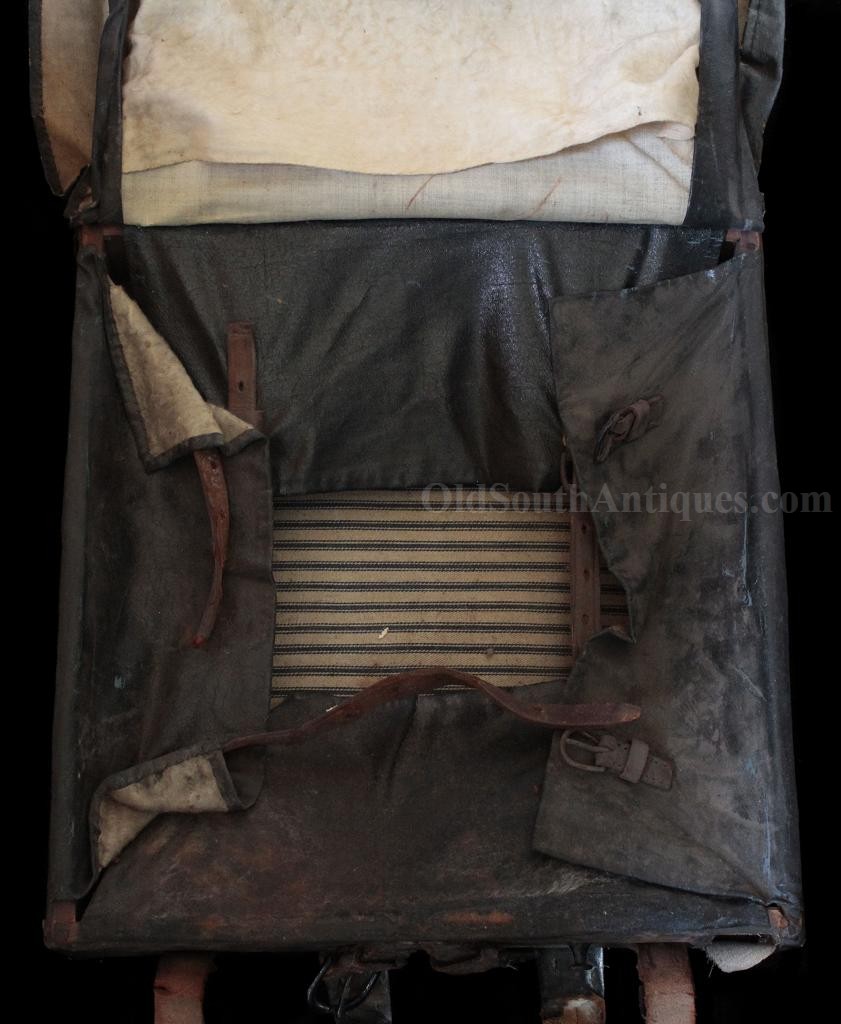
| Catalog | Past Items | Order Info | Terms/Conditions | About Us | Inventory Clearance |
In my nearly forty years of Collecting the Confederacy this is the best knapsack that I have ever owned. The knapsack itself is great, but the Confederate soldier’s painted identification, and the Yankee captor’s inked history, set it apart as truly remarkable.
The knapsack is purely Confederate made, from the raw cotton stuffed shoulder straps, to the buggy awning finials used to fasten its straps, it reeks of Confederate manufacture. It is hand lettered in white paint with its owner’s name on one side, and his address is painted on the other side.
Seventeen year old Marion D. Rodgers enlisted in Company H, 12th South Carolina Infantry at Rock Hill, South Carolina on August 13, 1861. He was fair skinned, had dark hair, blue eyes and stood 5’8”. A few months later, he was involved in the first of his many battles at Beaufort, South Carolina, known to history as the Battle of Port Royal.
On November 7, 1861 Yankee amphibious forces designed to capture Port Royal Sound and the port city of Beaufort. It consisted of seventeen warships, twenty-five coaling schooners, and thirty-three transports, which carried approximately thirteen hundred soldiers.
The Sound was protected by Fort Walker on Hilton Head and Fort Beauregard on Bay Point. The two forts mounted thirty-nine guns and were manned by 2,400 men under the command of General Thomas Drayton. Assisting the fortifications was a small squadron of makeshift gunboats under Captain Josiah Tattnall. The Federal forces rendezvoused off the sound on November 3rd. Four days later, on November 7th, the Yankee fleet entered the Sound. Tattnall’s gunboats were chased off, and the Wabash, Susquehanna, and Bienville kept the Confederates occupied in front of Fort Walker, the remainder of the fleet moved to a position on the fort’s northwest flank to enfilade the works. Later the Federal gunboat Pocahontas arrived off Fort Walker’s seaward flank and added her guns to the bombardment, completing the crossfire. Ironically, Captain Percival Drayton, brother of the Confederate commander, commanded the Pocahontas. After nearly five hours of fighting, the Confederates evacuated Fort Walker and Fort Beauregard and fled inland, abandoning Beaufort and the Sea Islands. It must have been at this time that Rodger’s equipment was abandoned. I know of another Confederate knapsack captured at this same time, so these must have been stored in one of the forts when the Confederates abandoned them.
I am unworthy to accurately judge the actions of soldiers on the battlefront, but it seems to me it was abandoned too easily. The battle cost Union forces eight killed and twenty-three wounded, while the Confederates on Hilton Head had eleven killed and suffered only forty-eight wounded. At Fort Beauregard, the Southerners suffered only thirteen wounded.
Shortly afterwards the Yankee army and navy established a huge military installation that served as headquarters for the South Atlantic Blockading Squadron and the Department of the South. Besides the obvious military advantages, the capture of Port Royal provided the enemy with a political and morale-boosting victory. It was a significant loss.
However, the 12thSouth Carolina Infantry and Private Rodgers did live to fight many more days. Rodgers fought the remainder of the War. The regiment continued to serve on the South Carolina coast until April, 1862, when it moved to Virginia. Assigned to General Gregg's and McGowan's Brigade, the regiment fought with the Army of Northern Virginia from the Seven Days' Battles to Fredericksburg. During the Chancellorsville operations the 12th was detached to guard ordinance trains and prisoners. With 340 men it marched 2,000 Federals to Richmond. Later the unit rejoined the brigade and continued the conflict from Gettysburg to Cold Harbor, then saw action in the Petersburg trenches and the Appomattox Campaign. It lost 17 killed and 121 wounded at Gaines' Mill, fifty-four percent of 270 at Second Manassas, 20 killed and 82 wounded at Sharpsburg, and thirty-six percent of the 366 at Gettysburg. The regiment sustained 102 casualties at The Wilderness, 118 at Spotsylvania, 34 from May 12th to July 1, 1864, 18 at Deep Bottom, 26 at Fussell's Mill, and 23 at Poplar Springs Church. It surrendered 10 officers and 149 men.
After making a fine
record with the Army of Northern Virginia, the 12th South Carolina pulled out
of the trenches on April 2, 1865 and Private Rodger’s was captured at Southerland
Station, just outside of Petersburg, Virginia on April 3, 1865, and was sent to
City Point, Virginia. The private, now
without a country, was released two months later on June 16th, when
he could finally begin to make his weary way back to his destitute and
destroyed homeland.
Copyright © 2025 OldSouthAntiques.com All Rights Reserved.
Privacy Policy | Terms of Use
Powered by Web-Cat Copyright © 1996-2025 GrayCat Systems









